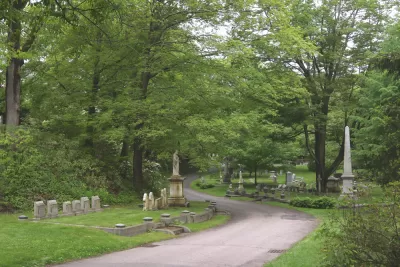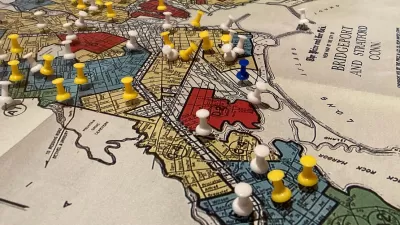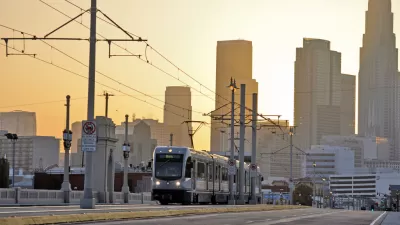Tracing the story of the American suburban form.

An article by Emma Newcombe in Governing describes the history of the American garden cemetery, starting with the Mount Auburn Cemetery outside of Boston, built in 1831 as the first of the sprawling rural cemeteries popular in the late 19th century.
As Newcombe explains, the early 1800s saw an increase in the sentimentality of Americans toward death and memorializing loved ones with pleasant, art-filled gardens, coupled with public health concerns about increasingly crowded urban burial grounds. Mount Auburn became a popular recreational site, with close to 60,000 visitors stopping in annually, and “By 1865, the United States had over 70 similarly landscaped cemeteries on the outskirts of cities, including Laurel Hill in Philadelphia, Green-Wood in Brooklyn and Mountain View in Oakland.”
The movement inspired a greater desire for urban parks and green spaces, with the New York state legislature setting aside 700 acres in New York City in 1853 that would become Central Park. Then, as the popularity of garden cemeteries and urban parks grew, developers started building America’s first planned suburbs, using similar principles to design new residential communities.
According to Newcombe, by the 20th century, rural cemeteries fell out of favor as maintenance costs grew and the Victorian fascination with death waned. Meanwhile, suburbs also became “far less picturesque and romantic than their 19th-century counterparts” as developers focused on cutting costs and building quickly, choosing “uniformity over picturesque asymmetry.”
FULL STORY: From Cemeteries to Suburbs: How a Romantic Movement Reshaped America

Alabama: Trump Terminates Settlements for Black Communities Harmed By Raw Sewage
Trump deemed the landmark civil rights agreement “illegal DEI and environmental justice policy.”

Study: Maui’s Plan to Convert Vacation Rentals to Long-Term Housing Could Cause Nearly $1 Billion Economic Loss
The plan would reduce visitor accommodation by 25% resulting in 1,900 jobs lost.

Why Should We Subsidize Public Transportation?
Many public transit agencies face financial stress due to rising costs, declining fare revenue, and declining subsidies. Transit advocates must provide a strong business case for increasing public transit funding.

Paris Bike Boom Leads to Steep Drop in Air Pollution
The French city’s air quality has improved dramatically in the past 20 years, coinciding with a growth in cycling.

Why Housing Costs More to Build in California Than in Texas
Hard costs like labor and materials combined with ‘soft’ costs such as permitting make building in the San Francisco Bay Area almost three times as costly as in Texas cities.

San Diego County Sees a Rise in Urban Coyotes
San Diego County experiences a rise in urban coyotes, as sightings become prevalent throughout its urban neighbourhoods and surrounding areas.
Urban Design for Planners 1: Software Tools
This six-course series explores essential urban design concepts using open source software and equips planners with the tools they need to participate fully in the urban design process.
Planning for Universal Design
Learn the tools for implementing Universal Design in planning regulations.
Smith Gee Studio
Alamo Area Metropolitan Planning Organization
City of Santa Clarita
Institute for Housing and Urban Development Studies (IHS)
City of Grandview
Harvard GSD Executive Education
Toledo-Lucas County Plan Commissions
Salt Lake City
NYU Wagner Graduate School of Public Service




























